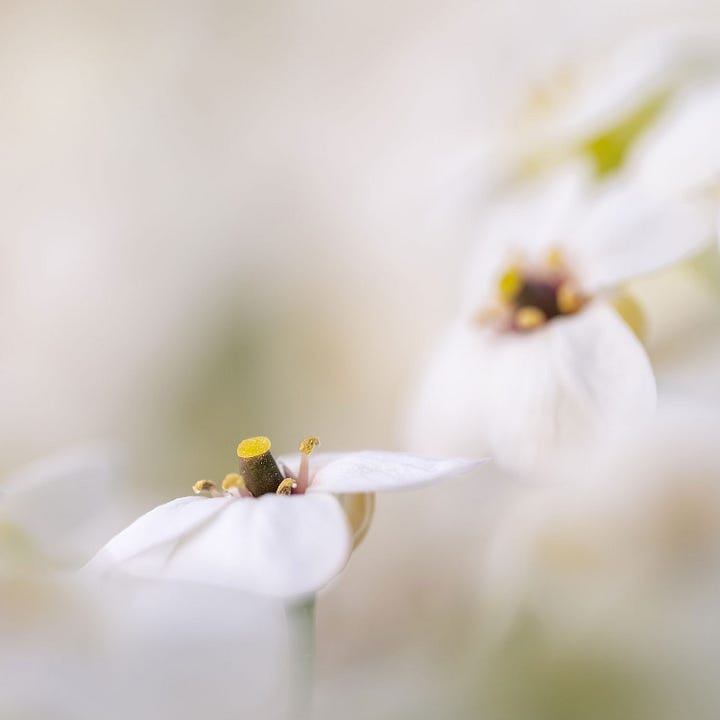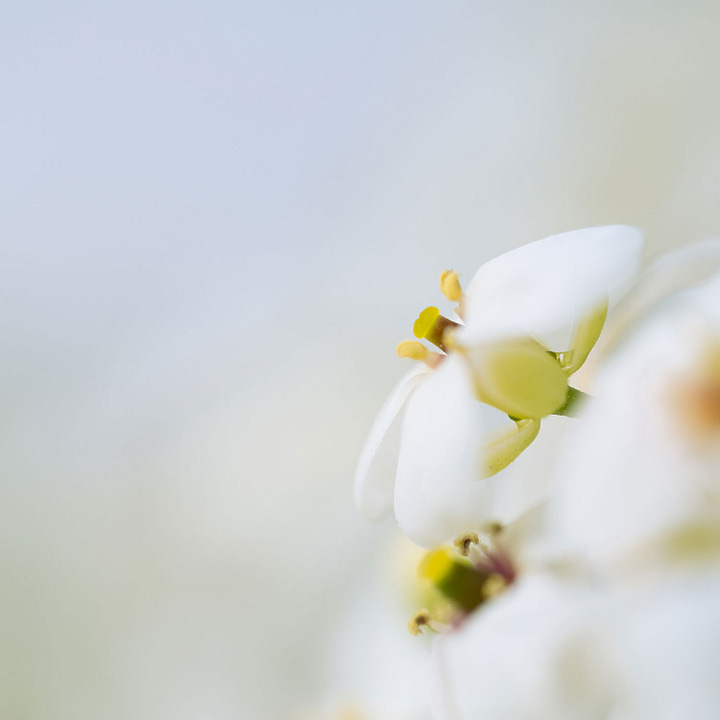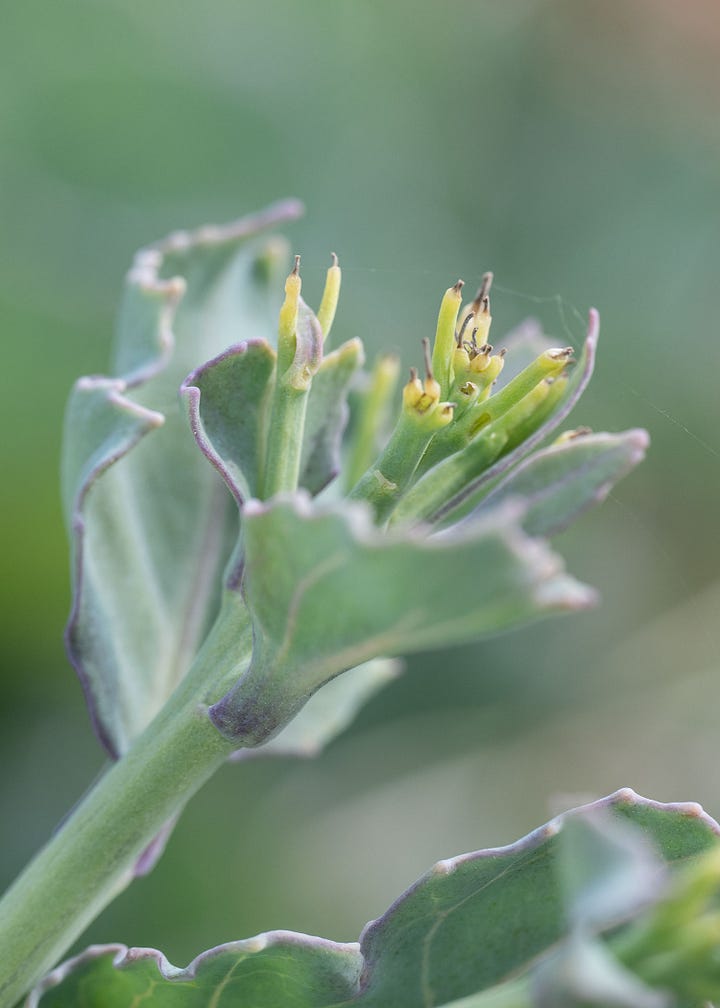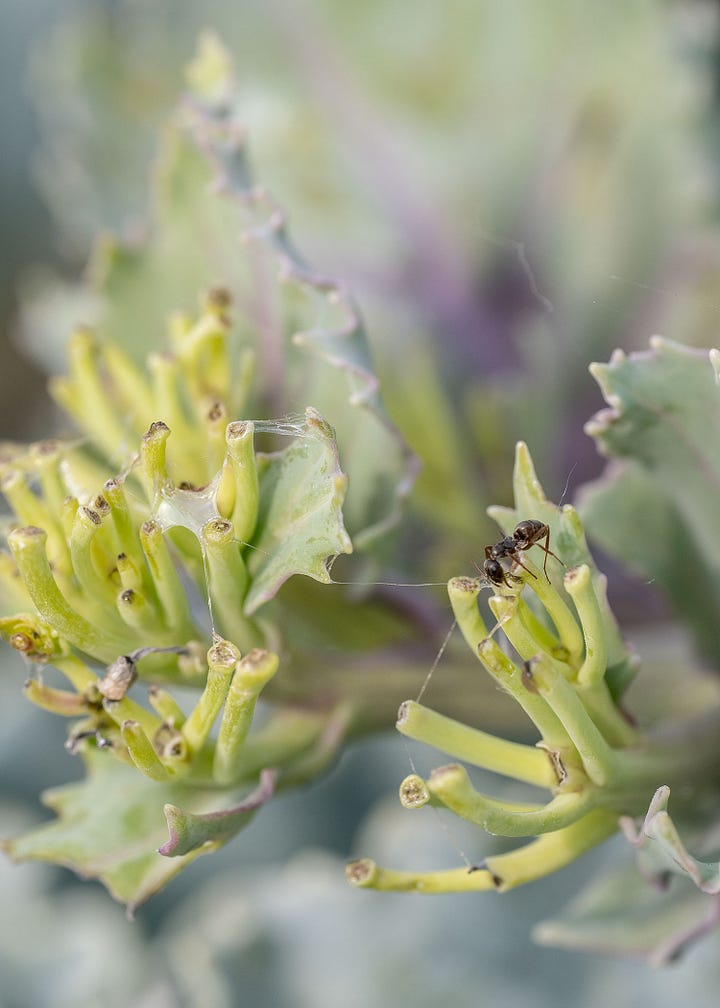Hello, I’m Gill and I write a photography blog inspired by the landscapes of Suffolk and beyond. Please subscribe to read more of my writing and visit my website to view my images.
For the past two weeks I have been a little obsessed with sea kale, a plant that grows all over the local shingle beaches of Suffolk. It is uniquely adapted to survive in these harsh coastal landscapes where sea spay, wind and poor soils provide difficult growing conditions. Sending down long tap roots in search of water the sea kale plant is a robust survivor, living beneath ground in the winter and bursting forth in spring with a vibrant display of creamy white flowers perched above fleshy grey green leaves. Hundreds of mounds of these drought tolerant plants grow along the length of the coast helping to stabilise the shingle and creating more hospitable environments for other wild species.


I have spent many hours this May photographing the sea kale flowers from one end of Suffolk to the other but I couldn’t help noticing that while the plants were blooming everywhere, the flowers on my local beach were non existent. A huge area of vegetated shingle, probably half a mile in length was covered in green mounds of sea kale, but there wasn’t a single flower in sight and I was beginning to wonder what was going on.
I have always been curious and I like to question everything (some would say this is not a good trait) but I think curiosity leads to knowledge. It also helps facilitate a connection to the landscape and as a result I think it definitely improves my photography.
I was deeply curious about the lack of flowers on my local sea kale but I was also immersed in a project to photograph them and create some connections between the plants and the beach upon which they live.
In January I decided that 2025 was going to be my year of connection and this small word has been the inspiration for several projects, some like the zine project I wrote about in my last post have come to fruition and some are ongoing. At the end of the year I want to see what I have achieved through my year of connecting deeply with the landscape, with local people and with other photographers. I want to see just how connection, in whatever form, can enrich our lives.
At the beginning of the year I launched my ‘Connection project’ - a collaborative venture to explore the connections we have with our local landscapes. I am now 6 months into the project and I wanted to share some of the challenges I have had with the body of work I am creating.
My idea has been to show my connection with nature through 8 images which portray how I feel about nature (or how nature makes me feel) in the face of global climate change and the environmental challenges the world faces today.
I began by writing down some words that came to mind when I thought about nature in 2025. From a list of about 30 I picked ten words that best describe how nature feels to me or how I feel about what is happening to nature in 2025. The words I picked are:
Happiness, joy, love, awe, alive, fear, anger, fragile, grief and hope.
Now my challenge has been to try and produce images that represent these words using landscape photography. I only intend to use 8 words for my final body of work but I felt it was a good idea to have a few extras to choose from to give me the best chance of producing some compelling images.
The biggest challenge has been producing images that describe a feeling. I always think about how I feel when I make an image but I am not usually going out with the intention of capturing a specific feeling, I am usually reacting to what I see at the time. Creating something to fit a particular word has been much harder to achieve and I have had to process some of my images in certain ways to get the look I want.
With this image taken in my local woodland I wanted to portray the idea of fear, even though I didn’t feel it at the time. I have used colder tones to process the image and darkened the trees to make them feel more imposing and I hope this has achieved the desired result.
For the word fragile I wanted to portray our disappearing wildlife but I wasn’t quite sure how to approach this. I ended up working with the flocks of cormorants that I regularly see flying up and down the coast. I decided to experiment with some ICM to render them indistinct and to make them feel undefined and unseen. I then inverted some of the images in photoshop and have combined these ‘mirror images’ with the originals to create white shadows which to me represent the hundreds of birds that have disappeared from our landscape in my lifetime.

As the year has progressed all the participants in this project have met regularly to discuss progress and this has been the biggest benefit and one of the most interesting aspects of the venture. It is fascinating to see how everyone deals with the same brief and how we all approach it in different ways. The images I have seen so far look amazing and by August we are going to have a lovely body of work to combine into a book and exhibition.
Working on these projects has definitely made me think about what connection means to me in terms of my photography, the landscapes I work in and the people that I meet and collaborate with.
With Coalescence the connection is all about colour in the landscapes of Assynt and how every place there can be connected to everywhere else by the colours of nature, which in their consistency have to the power to connect disparate places.
With my bigger connection project the link for all my images is how I feel. I am trying to describe my connection to nature and the landscapes of Suffolk by focusing on my emotions and exploring how nature (and what is happening to nature) makes me feel. I am also relishing the connection with other photographers which I find so inspiring.
Moving forwards I have another small project planned in my year of connection which will focus on my local beach and my connection to place. I have two ideas that I am going to develop into hand made books and I hope to explore these a little more in future articles.
So this brings me back to where my post began, with a story about sea kale and its missing flowers. By connecting with a local nature writer and using his connections to other biologists I think we have come up with a good theory for why the sea kale plants are bereft of flowers this year. It appears most likely that they have been eaten, probably by muntjac deer (which live in the gardens at the back of the beach) and probably as a reaction to the very dry spring we have had.


If I hadn’t have been curious and reached out and asked a question then I would have been none the wiser. And maybe if we had looked after our planet a bit better we wouldn’t have had such a dry spring and wildlife wouldn’t be under so much pressure. Everything in nature is connected and everything we do (large or small) has consequences and I hope we start to think about this a little more before it is too late.
If you would like to be part of my connection project I am running a competition to win a place in the book and the exhibition. If you have connections with Suffolk or have visited recently and would like to take part you will find more information here.
I still have a few copies of my Coalescence zine available and three places on my Assynt workshop if anyone would like to join us next November.
I hope you have enjoyed reading my update on my year of connection. For me connection is not just about photography and the natural world it is also about all the people I meet and collaborate with that make my life as a photographer so special.
Thank you so much for reading and if you have a story about connection, photography and nature that is personal to you then please share it in the comments. I would love to know how connection has enriched your life in whatever capacity.
Thank you very much for reading and until next time enjoy your photography.
Gill









Beautiful work Gill. Going out to find an image that conveys a particular feeling is the complete opposite to how I work - I think most landscape photographers find a scene and then see what they feel. I can't wait to see more.
Love your rendering of the birds in flight and your thoughts on processing to tell a story of lost wildlife .. thanks for sharing and I look forward to the finished project ..